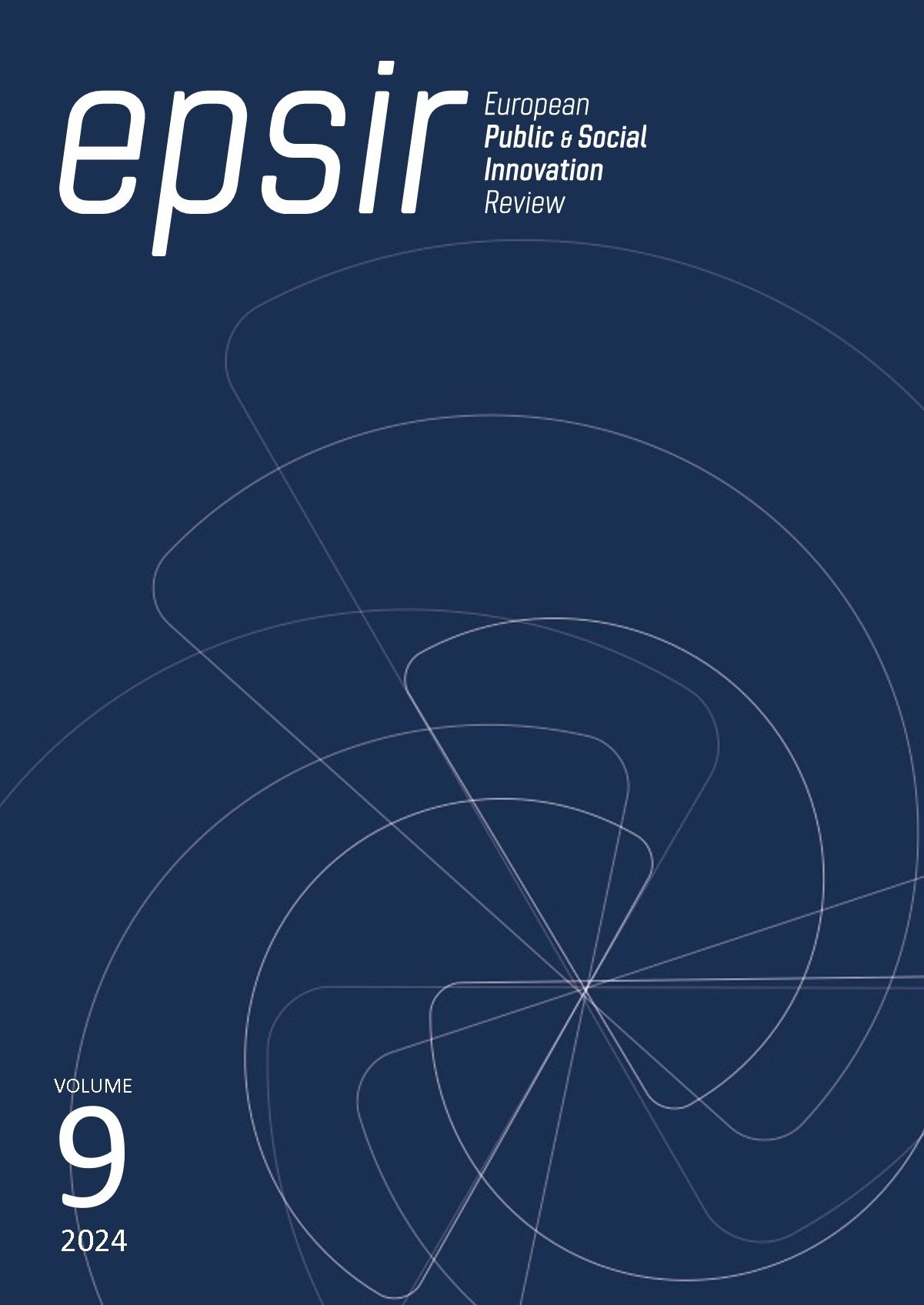The impact of innovation on the productivity and poverty of organic vegetable producers in Arequipa
DOI:
https://doi.org/10.31637/epsir-2024-1262Keywords:
Incidence, Innovation, Productivity, Poverty level, Organic products, Organic Producers, Vegetables, ArequipaAbstract
Introduction: The objective of this study is to analyze the impact of innovation on the productivity and poverty of organic vegetable producers in Arequipa. Methodology: The methodology used is of mixed approach, because it is quantitative and qualitative; non-experimental design, longitudinal (2008-2022) and cross-sectional (2022); it is descriptive, relational and explanatory in scope because it analyzes the incidence of innovation on productivity and poverty. The population is statistical data from reliable sources, the sample is 15 years, and to determine the relationship of the variables studied, an econometric model has been developed with data showing the results of the study. Results: The results according to the historical statistics found, determined that the variables are statistically associated. Discussions: Likewise, Pearson's Correlation, showed more low and moderate positive relationships than negative ones. In conclusion, innovation has a positive impact on productivity and decreases poverty of organic vegetable producers. Conclusions: Therefore, the effects of innovation in products, processes, organizations, marketing have increased the production, income level, as well as the improvement of the quality of housing with basic services of organic vegetable producers.
Downloads
References
Manual de Oslo. (2018). Directrices para la recogida e interpretación de información relativa a innovación. https://goo.su/46C1I
Banco Central de Reserva. (2022). Producto Bruto Interno. https://acortar.link/iF99AS
Banco Central de Reserva. (2023). Producto Bruto Interno. https://goo.su/hNQ8
Bartelsman, E., Falck, M., Hagsten, E. y Pólder, M. (2019). Productivity, technological innovations and broadband connectivity: firm-level evidence for ten European countries. Eurasian Business Review, 9, 25-48. https://acortar.link/NIzHrG DOI: https://doi.org/10.1007/s40821-018-0113-0
Borowski, P. (2021). Innovation strategy on the example of companies using bamboo. Journal of Innovation and Entrepreneurship, 10(3). https://doi.org/10.1186/s13731-020-00144-2 DOI: https://doi.org/10.1186/s13731-020-00144-2
Cano, D., Mendoza, A., Farfán, F. y Callave, D. (2022). Caracterización psicológica e imagen corporal de las mujeres con tatuajes: una revisión narrativa. En IX Jornada de Intercambio de Experiencias en Promoción y Educación para la Salud (pp. 44-51). Promoción de Salud Jujuy. https://goo.su/zRQMLe9
Carpio, C. y Afcha, S. (2020). Efecto de las barreras de innovación en la capacidad de absorción de las empresas innovadoras. Revista De Métodos Cuantitativos Para La Economía y La Empresa, 30, 3-22. https://doi.org/10.46661/revmetodoscuanteconempresa.2940 DOI: https://doi.org/10.46661/revmetodoscuanteconempresa.2940
Coronel, C. F. (2019). Procesos Administrativos y los Niveles de Productividad en los Colaboradores de la Financiera Confianza, Agencia el Agustino - 2018 [Tesis de doctorado, Universidad Autónoma del Perú]. https://hdl.handle.net/20.500.13067/792
Filla, C., Cardoso, A. L., De Assis, L., Mara, T. y De Siqueira, J. (2015). La fragilidad humana frente a la pobreza y el hambre. Revista Bioética, 23(1), 90-98. https://doi.org/10.1590/1983-80422015231049 DOI: https://doi.org/10.1590/1983-80422015231049
French, J., Montiel, K., y Palmieri, V. (2014). Innovación en la agricultura: un proceso clave para desarrollo sostenible. Inter-American Institute for Cooperation on Agriculture. https://goo.su/ieq1xGi
Gonzáles, M. y García-Vélez, D. (2019). Análisis de la pobreza en Ecuador a través de las Curvas TIP, 2009-2015. Revista Espacios, 40(1), 8-19. http://w.revistaespacios.com/a19v40n01/a19v40n01p08.pdf
Hinojosa, A. (2017). Efectos de la Innovación en la Productividad, en el Nivel de Pobreza de los Productores Orgánicos Beneficiarios del Cite Agroindustrial CEPRORUI El Taller, Arequipa 2008-2014 [Tesis doctoral, Universidad Católica de Santa María]. https://repositorio.ucsm.edu.pe/handle/20.500.12920/6479
López, L. (2023). Siete de cada diez peruanos son pobres o vulnerables de caer en pobreza, nuevo informe del Banco Mundial. https://goo.su/JJMeucD
Machaca Cabanillas, J. S. (2022). Gestión por competencias y productividad en la empresa Petropack S.A.C., San Juan de Lurigancho - 2020 [Tesis de licenciatura]. Universidad Autónoma del Perú. https://hdl.handle.net/20.500.13067/2434
Melitz, M. (2003). El impacto del comercio en las reasignaciones intraindustriales y la productividad agregada de la industria. Econometrica, 71, 1695-1725. https://doi.org/10.1111/1468-0262.00467 DOI: https://doi.org/10.1111/1468-0262.00467
Ministerio de Desarrollo Agrario y Riego. (2023). Problemas de la agricultura peruana. https://goo.su/WQqA1
Naciones Unidas. (2023). Acabar con la Pobreza. https://acortar.link/mxdete
Organización para la Cooperación y Desarrollo Económico. (2005). Manual de Oslo. Directrices para recopilar e interpretar datos de innovación. https://goo.su/C3vUn
Ramos, M. A. (2021). Aplicación del ciclo Deming para incrementar productividad del proceso de maquinado de ejes motrices en Factory Cubasa [Tesis doctoral, Universidad Cesar Vallejo]. https://hdl.handle.net/20.500.12692/83610
Rodríguez, B., Rodríguez, L., Suárez, C. y Torres, L. (2021). Innovación; camino a la obtención de beneficios [Seminario de investigación]. Universidad Externado de Colombia. https://goo.su/OG2jf2x
Rodríguez, Y. L. (2021). La gestión integral como una herramienta de la productividad. SIGNOS-Investigación en Sistemas de Gestión, 11(1), 11-21. https://www.redalyc.org/articulo.oa?id=560465980001 DOI: https://doi.org/10.15332/s2145-1389-4984
Rojo, M., Padilla, A. y Miguel, R. (2019). La innovación y su importancia. Revista Científica UISRAEL, 6(1), 9-22. https://doi.org/10.35290/rcui.v6n1.2019.67 DOI: https://doi.org/10.35290/rcui.v6n1.2019.67
Suárez, R. (2018). Reflexiones sobre el concepto de innovación. Revista San Gregorio, 24 julio-septiembre, 120-131. https://dialnet.unirioja.es/servlet/articulo?codigo=6839735
Toledo, W. (2017). El rol de las exportaciones en el crecimiento económico: evidencia de una muestra de países de América Latina y el Caribe. Revista de Economía, 34(89), 78-100. https://goo.su/trV5FgR DOI: https://doi.org/10.33937/reveco.2017.88
Valdés, C., Triana, Y. y Boza, J. (2019). Reflexiones sobre definiciones de innovación, importancia y tendencias. Avances, 21(4), 532-552. https://dialnet.unirioja.es/servlet/articulo?codigo=7090092
Downloads
Published
How to Cite
Issue
Section
License
Copyright (c) 2024 Anatolia Hortencia Hinojosa Pérez

This work is licensed under a Creative Commons Attribution-NonCommercial-NoDerivatives 4.0 International License.
Authors who publish with this journal agree to the following terms:- Authors retain copyright and grant the journal right of first publication with the work simultaneously licensed under Creative Commons Non Commercial, No Derivatives Attribution 4.0. International (CC BY-NC-ND 4.0.), that allows others to share the work with an acknowledgement of the work's authorship and initial publication in this journal.
- Authors are able to enter into separate, additional contractual arrangements for the non-exclusive distribution of the journal's published version of the work (e.g., post it to an institutional repository or publish it in a book), with an acknowledgement of its initial publication in this journal.
- Authors are permitted and encouraged to post their work online (e.g., in institutional repositories or on their website) prior to and during the submission process, as it can lead to productive exchanges, as well as earlier and greater citation of published work (See The Effect of Open Access).




